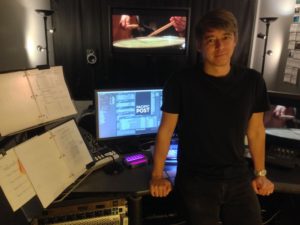Writer-director, Damien Chazelle, sent editor Tom Cross the script for his bittersweet romantic musical, La La Land, around March of 2014, right after Whiplash, their previous collaboration, played Sundance. At the same time Cross was given film

references and inspirations for the script. As time went by, the editor also received mock-ups of music the director was working on with composer Justin Hurwitz.
“He would keep me apprised of everything he was doing with Justin and his producers as they were developing the project,” noted Cross. “I would chime in some of my thoughts, but I was really not involved directly until they started shooting. That’s when I proceeded with dailies and putting the film together, but I knew from all the conversations what he was going for.”
After principal photography wrapped, Hurwitz set-up in a room adjoining editorial to facilitate the picture and music collaboration. Cross and director would be cutting picture, while the composer was creating score for the film. Editorial did not need to use temp music, the common practice during post-production. Sometimes the music would be conformed to the picture. Other times the picture was conformed to the music.
“We felt it was really important to have all of the music come from one place. To have it all be from one voice,” explained Cross. “The only way we could do that was to have Justin create temp score that would become real score.”
Cross found working on a musical generally more challenging than a non-musical. As part of his decision making process in making a picture cut, he considers factors such as emotions, story, and geography, which is the same with a musical, but there is the added element of music and how the cuts line-up with the music. Cross had separate vocal tracks for the musical scenes that he moved around to improve the sync. Sometimes he moved the picture to get a better match.

“You have things to consider like lip-sync,” said Cross. “Damien was very adamant that everything should feel organic. The emotion should feel authentic. Most audiences really scrutinize lip-sync in musicals more than they scrutinize the spoken dialog in non-musicals. We really had to work hard on that. When characters broke into song, we had to make sure that felt correct.”
As a jazz drummer, Chazelle is very precise in designing shots – a precision that is obvious from the film’s opening musical sequence on the highway overpass. The exactness gave the film an inherent rhythm. Cross worked to make sure the moments in the picture “hit on those very specific downbeats.”
Despite detailed planning, the final edit of the film did not always follow the script or storyboards. For example, the opening freeway scene, which the filmmakers referred to as “Traffic,” was the biggest musical number, and the most difficult to shoot. Shots were meticulously designed to be “stitched together in a very specific way.”
The scene was not the originally conceived as the opening of the film. During post the team discovered the main title sequence, scripted as an “overture” to the movie, did not function as intended and neither did the traffic scene. For a while the highway scene “hit the cutting room floor,” but that caused the first musical sequence – the scene with the roommates – to come almost twenty minutes into the film, which was too late. Ultimately the title sequence was dropped, the traffic scene was re-configured and the movie changed to its present opening structure.

“You can have something on the page that is perfectly written, but when you get people like Ryan Gosling and Emma Stone to inhabit the characters, when you commit it to film, something new happens.” Cross revealed, “You see the amazing looks and you say, ‘maybe we can just do it with looks, it’s so powerful.’ That’s how things change and that’s how they changed on La La Land. Things just evolve.”
The director wanted the editing to match the dynamics of each individual scene, which meant Cross had to use different editing styles dependent upon the scene. Some scenes have long, gentle, romantic wide-shots, featuring the dancing like musicals with Fred Astaire and Ginger Rogers. However, Chazelle felt those “beautiful romantic moments” would only have value if they were different from other moments in the movie. To provide the needed contrast in pacing, the dialog scene where Gosling and Stone meet is cut quickly, without a breath in between, highlighting the scene’s emotional intent that the two characters do not like each other at first.
In the old studio system, all crafts were readily available for the massive production requirements of a feature film musical. Chazelle had a very specific vision for La La Land that required “big efforts” from all the department heads that included, big production design, elaborate cinematography, great costumes and great music. For the movie to work there needed to be a strong collaboration with editing as the technical bridge held it all together.
“In a sense, Damien and his producers were re-creating the old studio system for this movie. They had to in order to make this film,” stated Cross.





